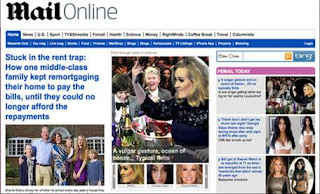Media Catch up - 16/10/18
Newspapers: Mail Online case study
MailOnline is the most successful English-language newspaper website in the world and one of the most popular news sources in the UK.
We need to study MailOnline alongside the newspaper version of the Daily Mail, again from the perspective of audience and industries. This is particularly important in terms of the editorial stance, the internet's influence on media power, the click bait-driven business model and the prevalence of soft news or social-media driven stories.
Notes from the lesson
Pluralism: a brief introduction
We need to study MailOnline alongside the newspaper version of the Daily Mail, again from the perspective of audience and industries. This is particularly important in terms of the editorial stance, the internet's influence on media power, the click bait-driven business model and the prevalence of soft news or social-media driven stories.
Notes from the lesson
Pluralism: a brief introduction
Pluralists see society as consisting of competing groups and interests, none of them predominant all of the time. Media organisations are seen as enjoying an important degree of autonomy from the state, political parties and institutionalised pressure groups.
A basic symmetry is seen to exist between media institutions and their audiences, since in McQuail's words the 'relationship is generally entered into voluntarily and on apparently equal terms’. Audiences are seen as capable of manipulating the media and as having access to what Halloran calls 'the plural values of society' enabling them to 'conform, accommodate, challenge or reject'. (Gurevitch et al. 1982: 1)
A basic symmetry is seen to exist between media institutions and their audiences, since in McQuail's words the 'relationship is generally entered into voluntarily and on apparently equal terms’. Audiences are seen as capable of manipulating the media and as having access to what Halloran calls 'the plural values of society' enabling them to 'conform, accommodate, challenge or reject'. (Gurevitch et al. 1982: 1)
Curran & Seaton: Power Without Responsibility
Curran and Seaton argue that the media should follow the pluralist model and be shaped by audience demand:
“The free market makes the press a representative institution…newspapers and magazines are to respond to the concerns of their readers if they are to stay in business.”
However, in practice the newspaper industry is dominated by a small number of powerful owners and this influences newspaper coverage and media influence. In short, the free market doesn’t work.
James Curran on the internet and power in the media
Watch James Curran interviewed by Barcelona Centre for Contempory Culture on Vimeo here.
MailOnline: audience-driven news
Curran and Seaton argue audience demand rather than powerful owners should influence news media. But can we trust audience demand?
Original MailOnline editor Martin Clarke said: “We let the readers decide what they’re interested in, that’s why MailOnline is so sticky and why it’s so addictive and why people love it so much.”
The homepage stories are selected by clicks – the most popular stories move to the top of the page. But does this turn news into ‘click bait infotainment’? Shouldn’t news be about informing the public – not entertaining them?
MailOnline: audience
MailOnline readership key details:
- Average age of 40
- 58% female
- 55% 18-44 year olds
- 68% ABC1
MailOnline: addictive design
MailOnline is designed to encourage readers to stay on the site: the homepage has (virtually) endless scroll, there are thousands of images, embedded social media posts and promotional features linked to the stories.
Celebrity gossip drives traffic to site (often via social media) with click bait used heavily to initially attract readers. Then, controversial headlines and opinion columns encourage users to comment, share and engage with the site.
The right-hand bar (‘sidebar of shame’) means an endless supply of celebrity gossip available on every page. This creates click bait within the site itself.

Comments
Post a Comment